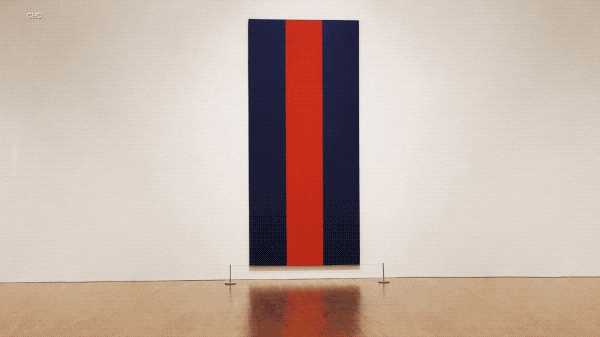Art 101: Why is this art?
Sometimes an artwork is more than what it looks like

Ever been to an art gallery with your uncle and he stares at a painting on the wall for like five long minutes and then he says, "WHY IS THAT ART?" and doesn't ever speak to you again?
Today, we're going to look at an example of when art might need a bit of context to answer your uncle's question. I'm Professor Lise (not really a professor) and this is Art 101 (not really a class). We're here to go on a deep dive on an idea, an artwork or a story from the art world that's controversial, inexplicable or just plain weird.
Watch the video:
In 1989, the National Gallery of Canada made a big purchase. It was a huge painting by an American artist named Barnett Newman called "Voice of Fire," painted in 1967, and the National Gallery bought it for a cool 1.8 million dollars.
And the country lost its damned mind. They drew cartoons. They said some really angry things, some of them kind of violent. Some people made their own versions of it for a lot less than 1.6 million.
Why did they hate it so much? "Voice of Fire" is 18 feet high, and it's made up of three stripes: blue, red and blue again.

So, your uncle might say: "This guy couldn't even use three colours! How damned long did it take to make? How much paint did he actually use? How much time could he have possibly spent? Does he think I'm an idiot?"
So why is it art? Let's go back.
Barnett Newman was born in 1905. (He's dead now.) He's seen as being part of a movement called Abstract Expressionism that included artists like Jackson Pollock, Mark Rothko and a couple of women whose names we left off the list (Agnes Martin and Lee Krasner) for about 50 years.

They were all asking questions about what painting actually was. What did it actually mean to paint on a flat surface? To not pretend it was three-dimensional? How could you evoke emotion or ideas through colour and brushstroke and texture? "Voice of Fire" came out of these experiments.
And politically, this was a fraught century! Leading into World War II, Russia and Germany and other countries had governments that controlled their artists and limited what they could paint — even creating laws around what you could put on a canvas! They introduced art movements with names like Socialist Realism to force artists to make paintings that served the state and called painters who made abstract art "degenerates."

So in the aftermath, when many painters had fled to the States, America of the 1950s and '60s was seen as a place where artists could have freedom, paint whatever they want and make huge ass abstract paintings. Abstraction could mean individuality and autonomy and free will.

"Voice of Fire" was a descendant of all of this and it was painted for a really important international exhibition called Expo '67, held in Montreal that year. Countries had their own pavilions, and "Voice of Fire" hung in America's. America was locked into the Space Race with Russia and, under the surface, this ideological war was playing out in the art world. Think: Portraits of Lenin versus massive screenprints by Andy Warhol AND "Voice of Fire."

What does this have to do with Canada? Newman painted his three massive stripes to specifically fit the size of the huge geodesic dome that was America's pavilion at Expo. This painting that meant so much at the Montreal show became part of Canada's cultural legacy — a slice of the history of the time, political as well as artistic.
Is this enough to convince your uncle that "Voice of Fire" is more than three tall stripes?
Maybe not. Uncles are tricky.
But it may be an example of why paintings like this make uncles angry and also why sometimes an artwork is more than what it looks like. I'll see you and your uncle back here next time for more Art 101.


